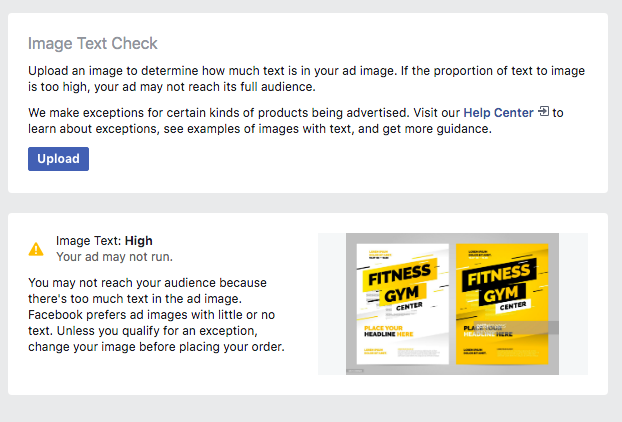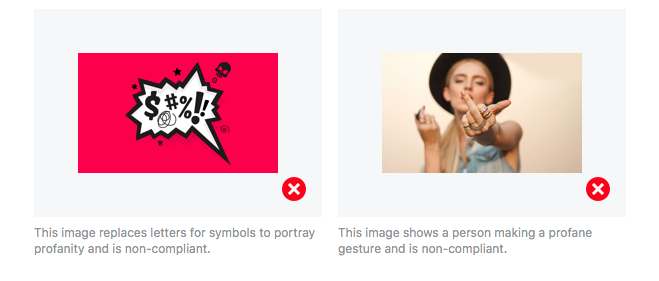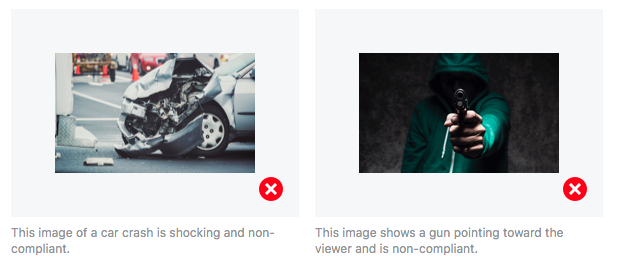Nobody likes being rejected. Especially when you’ve put extra hours into launching an awesome ad campaign – only to see it get shut down by the world’s 2nd largest advertising platform (after Google).
Facebook has had a tumultuous year that has resulted in a tighter ad policy and more extensive reviewing process (rightfully so). This means that marketers need to more contentious of the strategy and creativity that goes into their campaigns. Here are 5 types of common ads that have made it to Facebook’s prohibited content list.
Ads that have images with text
Facebook prefers ad images with little or no text, because images with a lot of text may create a lower-quality experience for people on Facebook. Text in your ad image includes text laid over a photo or illustration, text-based logos, or watermarks used in an ad's image. It also includes text in thumbnail images used for videos as well as images used as cover photos or profile photos of promoted Pages.
Use the text overlay tool to check if your images have less than 20% text.

Ads with bad grammar and profanity
Even if you’re trying to sound creative or transparent with your ad copy, be careful because Facebook might shut that shit down. Ads with bad grammar or ANY profanity will get rejected, this includes excessive symbols, characters, or punctuation along with any profanity that is partially obscured by asterisks or symbols. Here are a few examples on Facebook’s contraband list.
- “Get the best f*&%ing tshirts here.”
- “♧ ♥ ♡ ♢ ♢ Buy Now ♔ ♕ ♚ ♛ ⚜”
- “Tired of shitty cell service? Switch to a provider with better coverage.”
- Whÿ wónt yòu clîck mé?
- Buy Ga.rcin-ia Camb,ogia here

Ads that focus on personal attributes
Ads must not contain content that asserts or implies personal attributes. This includes direct or indirect assertions or implications about a person’s race, ethnic origin, religion, beliefs, age, sexual orientation or practices, gender identity, disability, medical condition (including physical or mental health), financial status, membership in a trade union, criminal record, or name.
An example would be an ad that references or or alludes to personal attributes or characteristics of the targeted group or individual such as “Do you have diabetes?” or “Broke? Bankrupt? Check out our services.” You should also refrain from using the word "other" to reference a personal characteristic such as “Meet other Seniors” or “Meet other black singles near you!”
Low quality or disruptive content
Ads must not contain content leading to external landing pages that provide an unexpected or disruptive experience. This includes misleading ad positioning, such as overly sensationalized headlines or prompts for users to inauthentically interact with the ad, and leading people to landing pages that contain minimal original content and a majority of unrelated or low quality ad content.
- Use ad images that are excessively cropped or require people to click the ad to view the full image
- Include deceptive or exaggerated ad copy that incentivizes people to click on your ad
- Feature sexually suggestive or shocking content on your landing page
- Display malicious or deceptive ads on your landing page
- Have a high ratio of ads relative to content on your landing page
- Use popup ads, interstitial ads or other ad formats that disrupt the user experience on your landing page

Ads that discriminate
Facebook prohibits advertisers from using ads products to discriminate against people. While most marketers would not deliberately create content that discriminates, they must be careful not to use the audience selection tools to wrongfully target or exclude specific groups of people. These include laws that prohibit discriminating against groups of people in connection with, for example, offers of housing, employment, and credit.
- U.S. Department of Housing and Urban Development
- U.S. Equal Employment Opportunity Commission
- Consumer Financial Protection Bureau
- American Civil Liberties Union
- Leadership Conferences on Civil and Human Rights
- Department of Justice – Civil Rights Division
- National Fair Housing Alliance
To learn more about Facebook's ad guidelines you can view their full list of policies directly from Facebook.. For more help with your content, click here.



Leave A Comment